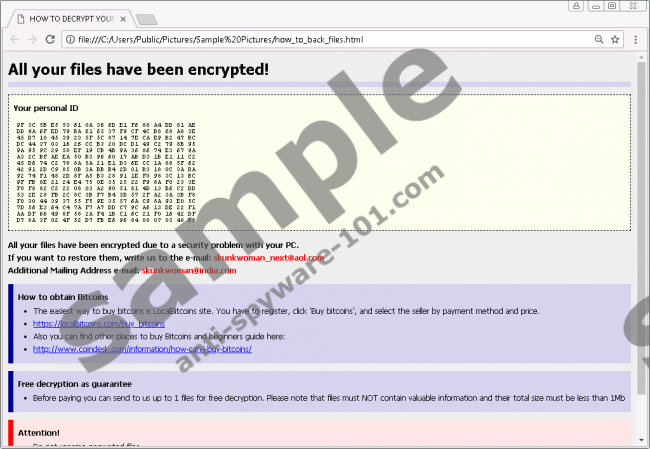What is .SKUNK File Extension?
You should see .SKUNK File Extension at the end of your files’ titles if you ever infect your computer with a malicious file-encrypting application known as Skunk Ransomware. If you happen to come across it all your documents, photographs, and other precious files could get ruined in just a couple of moments. The .SKUNK File Extension ransomware’s developers may guarantee they will decrypt locked files once the user pays a ransom, but in reality, there are no reassurances, because once the money is transferred the victim cannot take it back and we doubt these cybercriminals care what happens to encrypted data. Needless to say, if you do not think the hackers behind Skunk Ransomware can be trusted, we advise you not to risk your money. Instead, try to find copies you could use to replace encrypted files, e.g., some copies might be available through user’s cloud storage, social media accounts, removable media devices, etc. Just before attempting to recover any files it is vital to secure the system and erase the malware. To do so, get a legitimate antimalware tool you like or use the instructions available below.

Where does the .SKUNK File Extension ransomware come from?
Our researchers at Anti-spyware-101.com say the .SKUNK File Extension ransomware could sneak in after launching dangerous data downloaded from the Internet or after opening questionable attachments received via Spam emails. Moreover, it is possible the malware could be dropped by the cybercriminals who created it if they manage to gain access to the targeted computer. This they may achieve by exploiting the system’s vulnerabilities, such as unsecured RDP (Remote Desktop Protocol) connections. This is why, in addition to being cautious with suspicious installers, email attachments, or other data received from unreliable sources, we would also recommend always keeping your system and other software on it up to date. Plus, it is important the user picks strong passwords, so if you have any old and weak passwords you have not changed for a long time, it might be a good idea to upgrade them.
How does the .SKUNK File Extension ransomware works?
The malicious application works straight from the directory where the .SKUNK File Extension ransomware was launched without creating any additional data. It means it is enough to open the threat’s installer and it should start encrypting your files. During this process, the malicious application should encipher all user’s personal files, and it might even lock some of the programs installed on the infected computer. No doubt, the files belonging to the computer’s operating system should be left unaffected. Otherwise, the malware would be unable to show a ransom note as the system could become unbootable.
The mentioned ransom note is supposed to be available through an HTML file called how_to_back_files.html. The text on it should state “your files have been encrypted!” Then it ought to display a long ID number and instructions on how to pay the ransom, contact the hackers behind Skunk Ransomware, and decrypt a single non-important file for free as a way to guarantee they have and can provide decryption tools. The problem is while they might have and be able to provide the decryption means they may not actually do so. Thus, we advise users not to waste their money on something they might not receive and concentrate on the .SKUNK File Extension ransomware’s removal.
How to delete the .SKUNK File Extension ransomware?
One of the easiest ways to get rid of the Skunk Ransomware is to get a legitimate antimalware tool. While it scans the system, it should detect the .SKUNK File Extension ransomware and even other possible threats that later on you should be able to remove by pressing the deletion button. Another way to eliminate the malicious application is to erase its installer and ransom note manually. Since the task could be a bit difficult for some users, we will place instructions explaining it a bit below this paragraph.
Eliminate the .SKUNK File Extension ransomware
- Tap Ctrl+Alt+Delete.
- Launch Task Manager and go to Processes.
- Search for a process related to the malware.
- Mark the suspicious process and click End Task.
- Press Win+E.
- Check the following paths:
%USERPROFILE%Desktop
%USERPROFILE%Downloads
%TEMP% - Locate the infection’s installer, right-click the suspicious file and press Delete.
- Search your Desktop for a ransom note called how_to_back_files.html, right-click it and select Delete.
- Exit the File Explorer.
- Empty your Recycle bin.
- Reboot the system.
100% FREE spyware scan and
tested removal of .SKUNK File Extension*





0 Comments.